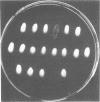Abstract
A practical slide agglutination test, with commercial antisera (Difco) and live antigens (antigens of live bacteria) taken directly from 24-h antimicrobial susceptibility plates, has been established for serotyping Pseudomonas aeruginosa. Until recently, the lack of both a standard antigenic scheme and a source of commercial antisera has made serological typing of this organism impractical. A simplified procedure with 17 unabsorbed antisera and live antigens prepared from materials readily available in most clinical microbiology laboratories makes epidemiological typing of this organism possible in hospital laboratories. The distribution of each serotype examined in this study was determined by using 425 consecutive patient isolates from six different hospitals. The distribution of O antigen groups (live antigen) was as follows: O1, 11.5%; O2, 1.6%; O3, 3.8%; O4, 7.8%; O5, 4.2% O6, 27.1%; O7,8, 5.9%; O9, 6.8%; O10, 2.4%; O11, 8.2%; O12 through O17, each less than 1%. Ten and six-tenths percent of the above agglutinated in two antisera, 3.3% agglutinated in more than two antisera, and 5.2% did not agglutinate in any antisera. A comparison of live and heated antigens shows that 93.2% were typable with the live antigen, and 94.5% were typable with the heated antigen. When both antigens were used, we typed 96.3% of 725 isolates. The reproductibility and specificity of the serological procedure were examined. We recommend using the live antigen for routine serological typing in clinical microbiology laboratories for “in house” epidemiology and reserving the heated antigen for reference and research typing (and for those few cases where results cannot be obtained using the live antigen). The application of serotyping in the study of outbreaks of P. aeruginosa is also presented.
Full text
PDF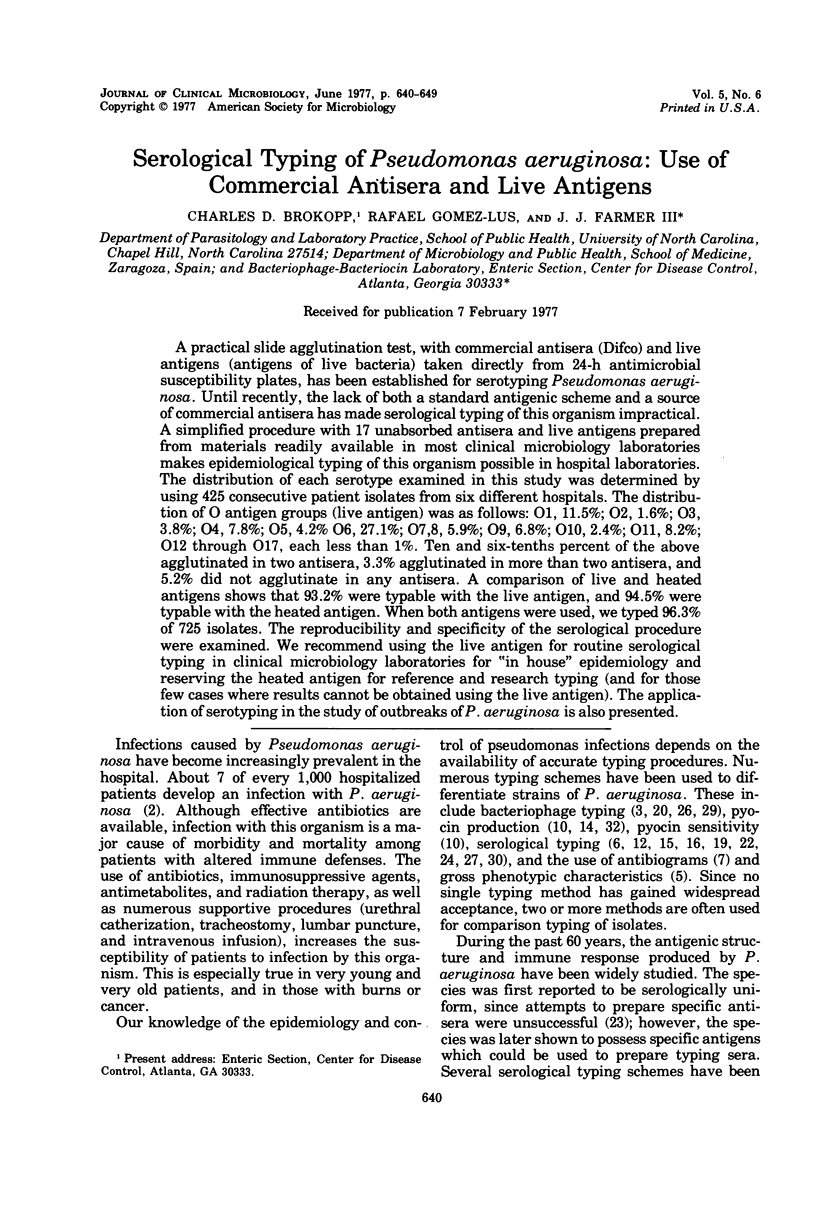


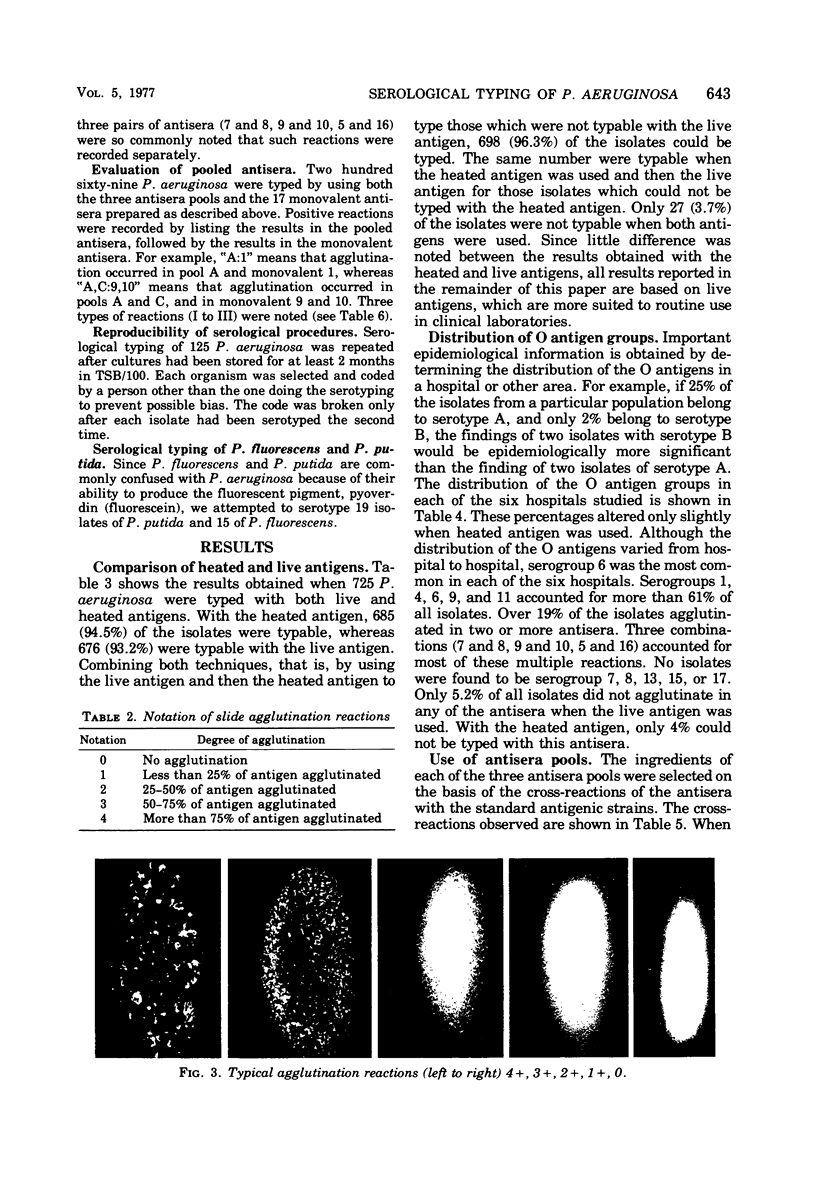



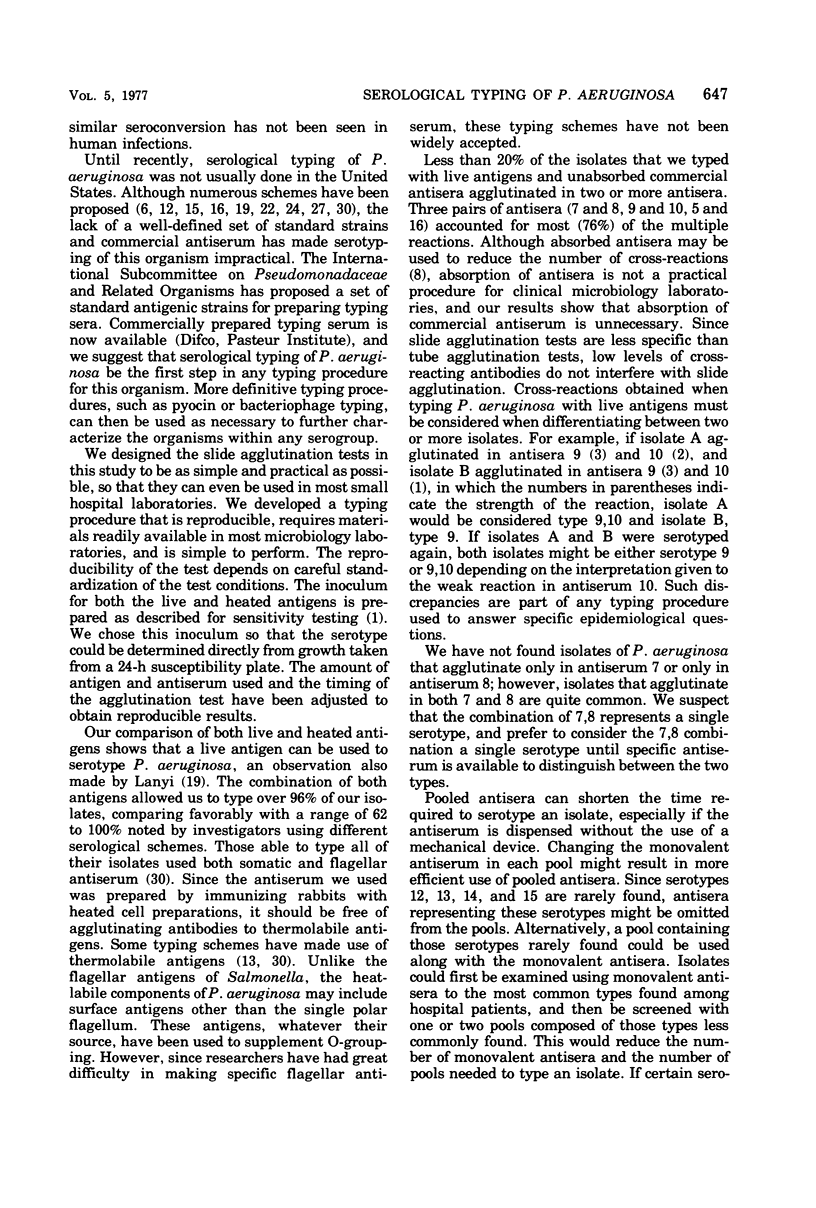

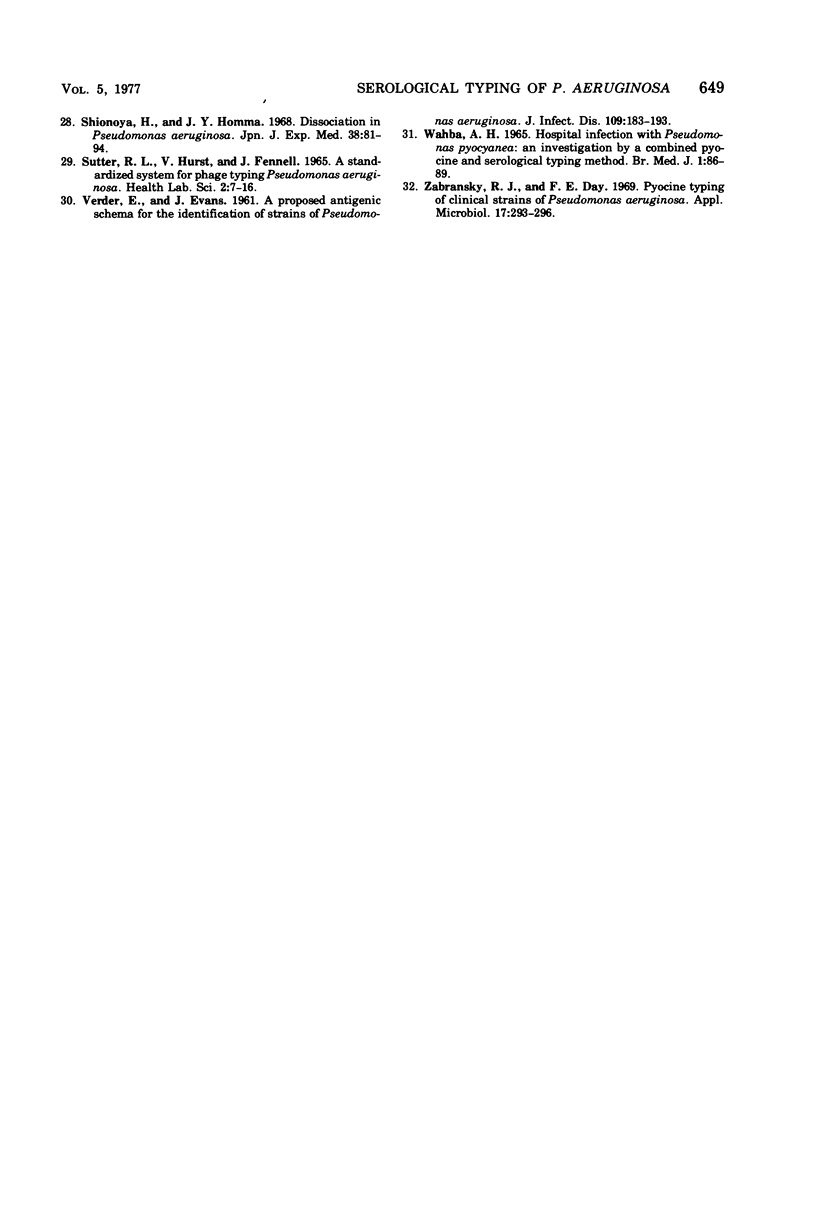
Images in this article
Selected References
These references are in PubMed. This may not be the complete list of references from this article.
- Bauer A. W., Kirby W. M., Sherris J. C., Turck M. Antibiotic susceptibility testing by a standardized single disk method. Am J Clin Pathol. 1966 Apr;45(4):493–496. [PubMed] [Google Scholar]
- Bergan T. A new bacteriophage typing set for Pseudomonas aeruginosa. 1. Selection procedure. Acta Pathol Microbiol Scand B Microbiol Immunol. 1972;80(2):177–188. doi: 10.1111/j.1699-0463.1972.tb00148.x. [DOI] [PubMed] [Google Scholar]
- Bergan T., Midtvedt T. Epidemiological markers for pseudomonas aeruginosa. Acta Pathol Microbiol Scand B. 1975 Feb;83(1):1–9. doi: 10.1111/j.1699-0463.1975.tb00062.x. [DOI] [PubMed] [Google Scholar]
- Bobo R. A., Newton E. J., Jones L. F., Farmer L. H., Farmer J. J., 3rd Nursery outbreak of Pseudomonas aeruginosa: epidemiological conclusions from five different typing methods. Appl Microbiol. 1973 Mar;25(3):414–420. doi: 10.1128/am.25.3.414-420.1973. [DOI] [PMC free article] [PubMed] [Google Scholar]
- Dayton S. L., Blasi D., Chipps D. D., Smith R. F. Epidemiological tracing of Pseudomonas aeruginosa: antibiogram and serotyping. Appl Microbiol. 1974 Jun;27(6):1167–1169. doi: 10.1128/am.27.6.1167-1169.1974. [DOI] [PMC free article] [PubMed] [Google Scholar]
- Duncan N. H., Hinton N. A., Penner J. L., Duncan I. B. Preparation of typing antisera specific for O antigens of Pseudomonas aeruginosa. J Clin Microbiol. 1976 Aug;4(2):124–128. doi: 10.1128/jcm.4.2.124-128.1976. [DOI] [PMC free article] [PubMed] [Google Scholar]
- Edmonds P., Suskind R. R., Macmillan B. G., Holder I. A. Epidemiology of pseudomonas aeruginosa in a burn hospital: evaluation of serological, bacteriophage, and pyocin typing methods. Appl Microbiol. 1972 Aug;24(2):213–218. doi: 10.1128/am.24.2.213-218.1972. [DOI] [PMC free article] [PubMed] [Google Scholar]
- Farmer J. J., 3rd, Herman L. G. Epidemiological fingerprinting of Pseudomonas aeruginosa by the production of and sensitivity of pyocin and bacteriophage. Appl Microbiol. 1969 Nov;18(5):760–765. doi: 10.1128/am.18.5.760-765.1969. [DOI] [PMC free article] [PubMed] [Google Scholar]
- Farmer J. J., 3rd, Hickman F. W., Sikes J. V. Automation of Salmonella typhi phage typing. Lancet. 1975 Oct 25;2(7939):787–790. doi: 10.1016/s0140-6736(75)80004-3. [DOI] [PubMed] [Google Scholar]
- Fisher M. W., Devlin H. B., Gnabasik F. J. New immunotype schema for Pseudomonas aeruginosa based on protective antigens. J Bacteriol. 1969 May;98(2):835–836. doi: 10.1128/jb.98.2.835-836.1969. [DOI] [PMC free article] [PubMed] [Google Scholar]
- Gaby W. L. Study of Dissociative Behavior of Pseudomonas aeruginos. J Bacteriol. 1946 Feb;51(2):217–234. [PMC free article] [PubMed] [Google Scholar]
- Gillies R. R., Govan J. R. Typing of Pseudomonas pyocyanea by pyocine production. J Pathol Bacteriol. 1966 Apr;91(2):339–345. doi: 10.1002/path.1700910207. [DOI] [PubMed] [Google Scholar]
- HABS I. Untersuchungen über die O-Antigene von Pseudomonas aeruginosa. Z Hyg Infektionskr. 1957;144(3):218–228. [PubMed] [Google Scholar]
- Homma J. Y., Shionoya H., Yamada H., Kawabe Y. Production of antibody against Pseudomonas aeruginosa and its serological typing. Jpn J Exp Med. 1971 Feb;41(1):89–94. [PubMed] [Google Scholar]
- Jones L. F., Zakanycz J. P., Thomas E. T., Farmer J. J., 3rd Pyocin typing of Pseudomonas aeruginosa: a simplified method. Appl Microbiol. 1974 Feb;27(2):400–406. doi: 10.1128/am.27.2.400-406.1974. [DOI] [PMC free article] [PubMed] [Google Scholar]
- Kawaharajo K. Changes in serotype of Pseudomonas aeruginosa. Jpn J Exp Med. 1973 Jun;43(3):225–226. [PubMed] [Google Scholar]
- Lindberg R. B., Latta R. L. Phage typing of Pseudomonas aeruginosa: clinical and epidemiologic considerations. J Infect Dis. 1974 Nov;130 (Suppl)(0):S33–S42. doi: 10.1093/infdis/130.supplement.s33. [DOI] [PubMed] [Google Scholar]
- Liu P. V. Changes in somatic antigens of Pseudomonas aeruginosa induced by bacteriophages. J Infect Dis. 1969 Mar;119(3):237–246. doi: 10.1093/infdis/119.3.237. [DOI] [PubMed] [Google Scholar]
- Lányi B. Serological properties of Pseudomonas aeruginosa. I. Group-specific somatic antigens. Acta Microbiol Acad Sci Hung. 1966;13(4):295–318. [PubMed] [Google Scholar]
- Meitert T. Contribution à l'étude de la structure antigénique des B. Pyocyaniques (Pseudomonas aeruginosa) Arch Roum Pathol Exp Microbiol. 1964 Sep;23(3):679–688. [PubMed] [Google Scholar]
- POSTIC B., FINLAND M. Observations on bacteriophage typing of Pseudomonas aeruginosa. J Clin Invest. 1961 Nov;40:2064–2075. doi: 10.1172/JCI104432. [DOI] [PMC free article] [PubMed] [Google Scholar]
- SANDVIK O. Serological comparison between strains of Pseudomonas aeruginosa from human and animal sources. Acta Pathol Microbiol Scand. 1960;48:56–60. doi: 10.1111/j.1699-0463.1960.tb04738.x. [DOI] [PubMed] [Google Scholar]
- SUTTER V. L., HURST V., FENNELL J. A STANDARDIZED SYSTEM FOR PHAGE TYPING PSEUDOMONAS AERUGINOSA. Health Lab Sci. 1965 Jan;2:7–16. [PubMed] [Google Scholar]
- Zabransky R. J., Day F. E. Pyocine typing of clinical strains of Pseudomonas aeruginosa. Appl Microbiol. 1969 Feb;17(2):293–296. doi: 10.1128/am.17.2.293-296.1969. [DOI] [PMC free article] [PubMed] [Google Scholar]



